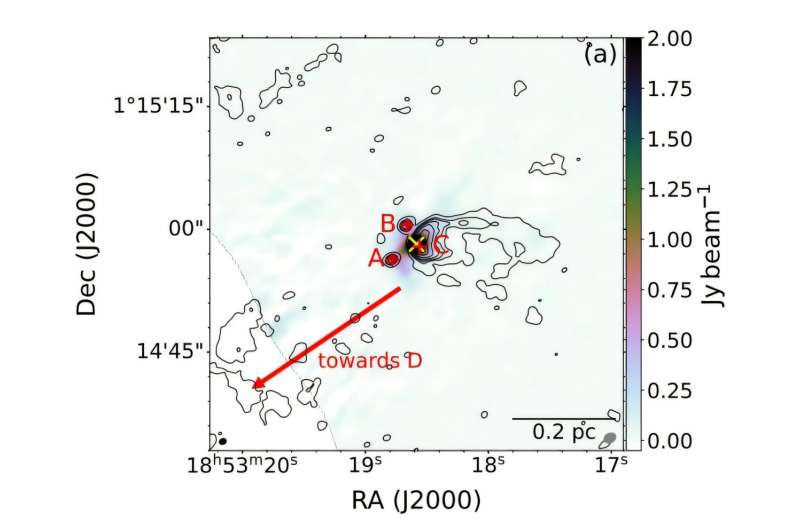By analyzing the data from the Atacama Large Millimeter/submillimeter Array (ALMA), astronomers have investigated a star-forming region known as G34.26+0.15. As a result, they discovered an explosive outflow in this complex. The study was reported in a paper published on April 22 on the arXiv preprint server.
G34.26+0.15 (G34 for short) is a high-mass star-forming region at a distance of some 10,760 light years from the Earth. It is part of a large-scale star-forming filament, including the Infrared Dark Cloud IRDC G34.43+0.24.
Previous observations of G34.26+0.15 have found that it contains four radio components, two of which are hypercompact (HC) regions of ionized atomic hydrogen (HII regions), and the others are a cometary ultracompact (UC) and a shell-like HII regions designated as A, B, C, and D.
Recently, a team of astronomers led by Namitha Issac of the Shanghai Astronomical Observatory in China investigated archival ALMA data regarding G34.26+0.15, in order to shed more light on its properties. Their study, which was complemented by data from the Very Large Array (VLA) and the James Clerk Maxwell Telescope (JCMT), resulted in the detection of an outflow from this source.
According to the study, ALMA images have revealed the presence of multiple outflow streamers associated with G34. These streamers have nearly linear structures and seem to emanate from a common center within the ultracompact HII region.

The study found that half of the identified streamers are receding, reaching radial velocities of up to 62 km/s, and the other half of them are approaching, reaching up to −58 km/s with respect to 58 km/s (the systemic velocity of G34). The astronomers noted that the radial velocities of the streamers point to an explosive nature of the outflow.
The authors of the paper assume that the explosive event that initiated the outflow appears to have occurred about 19,000 years ago. They added that this event may also be the mechanism that powers the expanding UC HII region.
“The event triggering the outflow may have occurred about 19,000 years ago and could also be responsible for powering the expanding UC HII region, given the similar dynamical ages and positional coincidence of the UC HII region with the origin of the outflow,” the researchers explained.
Summing up the results, the scientists noted that the explosive outflow in G34 might be responsible for aligning the magnetic field along the outflow direction. They underlined that, all in all, their discovery is an important addition to the still small sample of rare explosive outflows observed in our Milky Way galaxy.
“This gives a total number of 200 explosive events in the galaxy and the rate of explosive events to be one in every 160 years,” the astronomers concluded.
More information:
Namitha Issac et al, Detection of an Explosive Outflow in G34.26+0.15, arXiv (2025). DOI: 10.48550/arxiv.2504.15748
© 2025 Science X Network
Citation:
Astronomers discover explosive outflow in star-forming complex using ALMA data (2025, April 29)
retrieved 29 April 2025
from https://phys.org/news/2025-04-astronomers-explosive-outflow-star-complex.html
This document is subject to copyright. Apart from any fair dealing for the purpose of private study or research, no
part may be reproduced without the written permission. The content is provided for information purposes only.

